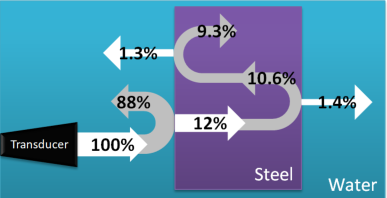SLDA058 March 2021 TUSS4470
- Trademarks
- 1Review of Ultrasonic Sensing Range Performance Factors
- 2Methods Overview
- 3Short Range Air-Coupled Test Results
- 4Mid-Range Air-Coupled Test Results
- 5Short Range Water-Coupled Test Results
- 6Resistive Damping Device Comparison
- 7Summary
- 8References
- A Appendix A
- B Appendix B
1.1 Physical Parameters
The ultrasonic wave transmission medium, target composition, and target radar cross-section fundamentally impact the attainable range using a given transducer. For example, air-coupled ultrasonic transmissions are practically limited to below 500 kHz due to the wave dissipation through air. Generally, transmission range is inversely proportional to transducer frequency. The material composition and acoustic impedance mismatch of the target impacts the attenuation of the wave as it is reflected off of the surface.
 Figure 1-1 Reflection Coefficients for Water
and Steel Boundaries
Figure 1-1 Reflection Coefficients for Water
and Steel BoundariesLikewise, scattering or wave misdirection, due to the radar cross section of the target, can have a major impact on the return ultrasonic echo SPL.
 Figure 1-2 Target Geometry Impact
Figure 1-2 Target Geometry Impact